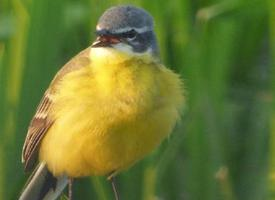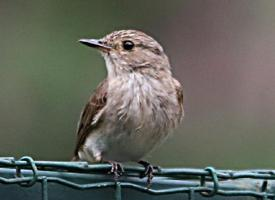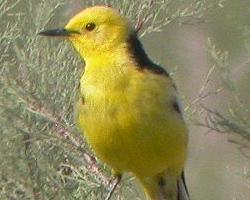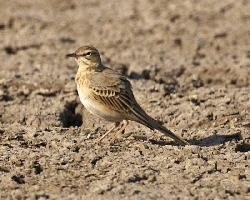
Statut de conservation
| Menacé |
Description de l'animal
The Western yellow wagtail (Motacilla flava) is a small, slender passerine bird that is a member of the wagtail family, Motacillidae. This charming species is well-known for its vivid plumage and distinctive tail-wagging behavior, from which it gets its common name.Adult Western yellow wagtails typically measure about 16-19 cm in length, with a wingspan ranging from 25 to 30 cm. They are characterized by their relatively long, narrow tails which they often wag up and down, especially when foraging on the ground. This tail movement may serve multiple purposes, such as flushing out insects or communicating with other wagtails.
The plumage of the Western yellow wagtail is one of its most striking features. Males in breeding plumage display a bright yellow underbelly, ranging from a rich lemon to a golden hue, which extends up the chest and can include the throat and face in some subspecies. The upperparts are typically an olive-green or grey, and there is often a distinct white or light eyebrow stripe, known as a supercilium, which contrasts with the darker head. Non-breeding males, females, and juveniles are generally duller, with more subdued yellow tones and less pronounced facial markings.
The Western yellow wagtail has a light and agile flight pattern, with rapid wing beats that allow it to make quick turns and sallies in pursuit of flying insects. Its diet consists primarily of insects and other small invertebrates, which it catches on the ground or in the air. During the breeding season, the availability of insect prey is crucial for feeding nestlings.
Breeding habitats for the Western yellow wagtail are typically open areas near water, such as wet meadows, marshes, and riverbanks across Europe and Asia. They prefer areas with short vegetation, which makes it easier for them to spot and catch prey. These birds are migratory, with many populations traveling to sub-Saharan Africa to spend the winter in warmer climates.
The nest of the Western yellow wagtail is a well-concealed cup built on the ground, often hidden among vegetation or in a small depression. The female usually lays a clutch of 4-6 eggs, which are incubated by both parents. The chicks are altricial, meaning they are born naked and helpless, and require significant parental care before they can fledge.
The song of the Western yellow wagtail is a pleasant, melodious twittering, often delivered in flight or from a perch. Their calls include a sharp "tsweep" or "tsilip," which can be heard throughout their territories.
Conservation status for the Western yellow wagtail varies by region and subspecies, but habitat loss and degradation, particularly the drainage of wetlands and the intensification of agriculture, are significant threats to their populations. Conservation efforts focus on preserving and restoring their natural habitats, as well as ensuring safe migratory routes.
In summary, the Western yellow wagtail is a captivating bird with distinctive behavior and a colorful appearance that makes it a favorite among birdwatchers and naturalists. Its presence is often indicative of healthy wetland ecosystems, and its life cycle is closely attuned to the availability of insect prey and the rhythm of the seasons.
Animaux similaires
Nouvelles photos d'animaux
Top 10 des animaux
- Dolphin gull (Leucophaeus scoresbii)
- Diana monkey (Cercopithecus diana)
- Moustached guenon (Cercopithecus cephus)
- Galápagos tortoise (Geochelone nigra complex)
- Russian tortoise (Testudo horsfieldii)
- Stone loach (Barbatula barbatula)
- Japanese macaque (Macaca fuscata)
- Common flying dragon (Draco volans)
- Greek tortoise (Testudo graeca)
- Vendace (Coregonus albula)


